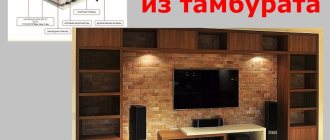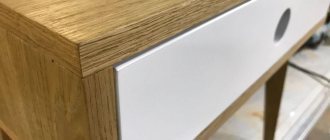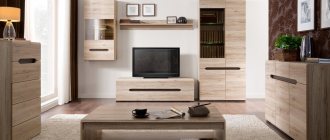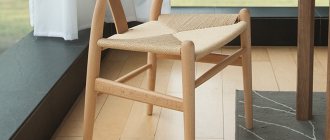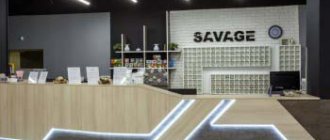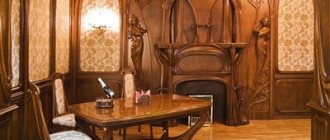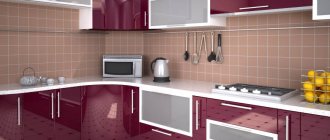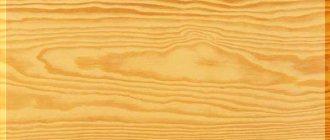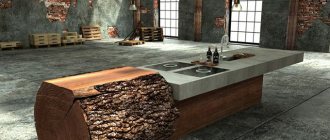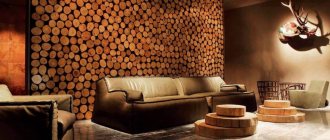Tamburat, or sandwich board, is a universal material for making furniture. It has a tiered structure, where the outer layers consist of MDF, chipboard or plywood, and the inner layers are made of lightweight paper and cardboard filler. The honeycomb middle allows the tamburat to demonstrate:
- Light weight.
- Resistance to deformation.
- Versatility.
It is possible to make very long or high parts from tambourate; it perfectly retains its rigid structure. To increase stability, the material can be lined with PVC film, veneer, etc.
Thanks to the unique structure of the vestibule, furniture items made from it are lighter than usual by 50 to 70%. It also makes it possible to hide cables or wiring if necessary.
Furniture made from vestibule is easy to use and can maintain its aesthetics and function for a long time. A wide range of colors allows you to fit it into the interior as naturally as possible. The abundance of textures and types is achieved due to the predisposition of tambourate to processing. Milling, drilling and sawing with this material are easy to do.
Stylish and respectable tambourate products are indistinguishable from natural wood in appearance. Minimal restrictions regarding the internal climate make it possible to purchase furniture from this material for both offices and residential premises.
We use high-quality fittings to securely connect the filler to the internal slabs, as well as modern tools to give the tambourate the required shapes.
DM-decor will help you choose vestibule furniture in accordance with your expectations and needs. We:
- We will offer affordable and universally applicable options.
- We will ensure that the fasteners match the type and thickness of the product.
- We will calculate the maximum loads and tell you how to prolong the joy of your purchase.
With us you will be able to use the design capabilities of the material to the maximum, obtaining unique and attractive furniture made from vestibule. Read below about what you can order from us.
Tambourate cabinets
Designer custom-made tambourine cabinets will allow you to use space efficiently. The variety of shades will allow you to choose a color that perfectly suits your interior. The production of custom-made cabinets takes into account the characteristics of the room. So, for example, we can produce:
- Built-in models.
- Corner and straight options.
- Sliding (where there are sliding doors) and hinged wardrobes.
For additional convenience, furniture items are equipped with shelves, drawers and other structural elements. To increase the space for storing things, there are cabinets with a mezzanine, and for true fashionistas we offer options with a mirror. DM-Decor takes into account the wishes of customers and the architecture of the rooms, implementing tambourate cabinets:
- to the library;
- to the dressing room;
- to the living room;
- to the nursery;
- to the hallway;
- to the bedroom.
Tamburat shelving
Custom tambourate shelving manufactured by DM-Decor is unpretentious, easy to use and durable. At your request, we can design a laconic model that will find a place in a classic interior, and a complex design solution for an Art Deco style setting. Racks are produced according to the customer’s own measurements, photos, and sketches.
Options could be:
- Open;
- Combined (closed compartments and accessible sections);
- Closed.
Depending on the client’s requirements, we will offer a straight or corner model, multi-tiered or low design, where you can easily place souvenirs, household items, and books.
Tamburat - furniture board
Tamburat is a modern construction material that consists of two outer sheets and a filler. The idea to create slabs with a honeycomb structure appeared back in 1943, but implementation began only 20 years later. For a long time, developers searched for the ideal filler. They eventually settled on compacted cardboard.
The outer layers are made of wood-containing material or plasterboard with surface veneer. And the middle is made of thick cardboard and is located in the shape of a honeycomb with dimensions from 15 to 25 mm. The vestibule does not have strict dimensions. Companies producing this material offer quite a variety of sheet sizes. Thickness ranges from 30 to 240 mm, length from 2400 to 3000 mm, and width from 600 to 1300 mm.
Article on the topic: DIY furniture made from unedged boards
Dressing rooms made of vestibule
Custom-made walk-in closets allow you to take into account the size and design differences of the room when filling it. Options from DM-Decor are:
- rational location on the allocated square meters;
- optimal filling taking into account the configuration;
- convenience and ease of use.
We produce wardrobes of any complexity, type and style. The storage system makes it possible to use every corner to place and keep in order as many personal items as possible. DM-Decor will develop a project for a dressing room:
- in a niche;
- in the corner;
- in the attic;
- on the loggia;
- in the pantry;
- in a full room.
A properly selected vestibule design will provide full visibility and quick access to clothing and accessories, allowing you to save time on getting ready. DM-Decor will take care of the correct zoning of your dressing room:
- lower area with shoe shelves and drawers;
- middle zone with hanger bars, open shelves, hooks;
- upper zone with hat shelves.
Compatibility with other materials
Tamburat fits perfectly with all known components used today in the process of designing and creating furniture. A wide selection of fastening materials guarantees the compatibility of the component elements of the product, even when they are created from different raw materials - chipboard, MDF, plywood, natural wood, glass, mirrors, aluminum and MDF profiles, acrylic plastic, postforming, perforated metal, decorative relief plastic.
In addition, experts advise using parts made from simple laminated chipboard as vertical partitions and horizontal shelves to create closed areas of the body. As a result, it is possible to reduce the cost of the final product without compromising the performance and aesthetic qualities of such furniture. The open parts of the body will create the effect of massiveness, and the internal components of the closed areas of the structure have absolutely no effect on the appearance.
Furniture for the hallway made of vestibule
Custom-made vestibule furniture for the hallway will make it possible to solve the problem of arranging the entrance area with maximum comfort. Simple lines or complex design - DM-Decor will make the dream of an ideal corridor come true. Universal groups with hangers, hooks, plenty of shelves and compartments, chests of drawers and banquettes are designed to make your hallway welcoming. What the complex may include:
- Hallway wardrobe with mirror, cabinet or chest of drawers.
- Closed wardrobe with internal filling.
- Extended set with consoles and shoe racks.
We can also produce individual pieces of furniture so that you can update and improve your existing interior. Elements for the hallway made of vestibule are beautiful and non-trivial. You won't notice how:
- Free space;
- Maximum convenience;
- Pleasure to use.
How to make tambourate or furniture board
So, we have already figured out that tambourate is a frame slab with light weight. The production of furniture boards or tambourates is simple.
So, to make a tambourate, take two sheets of plywood (MDF, fiberboard, chipboard and others), 3.4 or 8 mm thick. Craft filler with a honeycomb structure is placed between the sheets. The entire structure is glued together. A protective edge is glued to the sides. The protective edge is usually made of PVC. Has a thickness of no more than 3mm. An embedded strip made of foamed ABS or plywood is placed under the protective edge. This is done so that the edge holds better.
Article on the topic: Do-it-yourself carved solid wood furniture
Tamburat or furniture board. Kinds
There are three types of tamburat. Each type of furniture board differs in the way it is processed. So there is uncoated, coated and standard decorated.
- The standard-decorated tambourate is finished in lacquered paper, plastic or wood veneer
- Coated tambourate usually has a final finish in the form of wood veneer, film or paper-laminated coating
- Uncoated tambourate requires additional processing before use. You can cover it with PVC film, paper or veneer
Tambourate tables
Custom tambourate tables are an excellent replacement for bulky and heavy pieces of furniture from the past. DM-Decor will produce the following models:
- for kitchen;
- for living rooms;
- for an office or study.
Attractive and moisture-resistant tables with a hygienic surface that is resistant to scratches and other mechanical stress will find a worthy place and use in the home and at work.
We will produce tables for you:
- Written, working or student.
- Dining, bar and cutting.
- Magazine and coffee shops;
- Side and serving;
- Toilet;
- Computer;
- Universal.
It is possible to order classic designs and transformable tables.
Tambourate chairs
Custom-made vestibule chairs for the kitchen, dining room, office or living room will serve you for many years. The material is not subject to aging and is able to maintain its original appearance with careful use.
DM-Decor produces models:
- Massive and miniature;
- Minimalistic and decorative;
- High and low.
We produce furniture items of classic and original shapes, with or without backs. You can order a set of table and chairs or buy a single copy. The material can withstand a rider of any size. Tamburat chairs are used even in high-traffic areas, so you can be sure that they will not be damaged by the sudden arrival of guests.
Features of sandwich furniture
The technology for producing sandwich panels appeared relatively recently and quickly gained popularity in the construction industry. Gradually, this technology began to be used in the manufacture of furniture, which is explained by the characteristics of the material.
Advantages
At the moment, there is a wide variety of building materials that are suitable for the manufacture of furniture and various interior items. All of them have both advantages and disadvantages.
When drawing up a housing project, it is worth familiarizing yourself with the advantages and features of various materials, which will allow you to make the right choice.
The sandwich design is characterized by the following advantages:
- Ease of processing. Any person can cut a tambourate slab, and no special tools are needed for this.
- Possibility of hidden installation. Explained by the density of the filler. In addition, the fastening elements are easily hidden inside the furniture without spoiling its appearance.
- Ability to combine with other materials. The design assumes classic fasteners. However, if very thin sheets are used, they should be mounted using special recessed fasteners.
- Strength. This characteristic largely depends on the characteristics of the filler. Its design involves many stiffening ribs that can easily withstand increased loads.
- Resistance to bending. Thin products bend easily, while remaining strong and rigid. Due to this, rounded or concave elements are often made from the material.
- Decorative coatings. They are available in a wide variety so that the final product can have a unique look.
- Light weight. Despite the large volume of parts, the products are not heavy. This feature allows the panels to be used to produce impressive structures that will not create difficulties during transportation.
- Availability. The cost is low.
As you can see, sandwich panels have enough positive qualities, so they are widely used.
What does tamburat consist of?
Tamburat is a lightweight frameless slab consisting of three layers. External ones can be made of chipboard, MDF or plywood, with a thickness of 3 to 8 mm. The inner layer is a honeycomb paper and cardboard filler. Just ten years ago, such designs were used quite rarely; their number on the market did not exceed 12%. Today, production capacity and the availability of material have made it possible to increase the production of tamburate, the share of which is already about 40%.
“Sandwich” - translated from English means “sandwich”. The material for furniture production has a similar design. This slab is made from tambourate with a thickness of 50 mm.
- internal filler;
- top and bottom front panels 10 mm thick;
- an internal frame installed around the perimeter of the slab.
Despite the simple components, this combination allows you to achieve significant performance characteristics. This is precisely what explains the demand for this material in many areas of human activity.
What is made from tambourate?
This is a highly targeted material that is most often used in furniture production.
Tamburat is relevant for the following purposes:
- Creation of volumetric structures. Often, instead of chipboard, a tambourate is installed.
- Formation of furniture collections. Typically, they consist entirely of a sandwich. In terms of manufacturing, these are the simplest designs compared to the use of other wood-based materials. And yet the finished furniture turns out to be practical and beautiful.
Using tambourate slabs you can make almost any item. However, there is an exception: bathroom furniture cannot be created, since the material does not tolerate high humidity.
Tamburate is also classified by thickness:
- 32 mm. Interior doors and doors for closets are made from such panels.
- 38 mm. This thickness is optimal for creating shelving and cabinets. But there is a limit on the length of the shelves - from 50 to 100 cm.
- 50 mm. Tabletops, shelving, tables, commercial and banking equipment are made from slabs. Shelves can be more than 1.5 m long.
The optimal thickness for the material is 8 mm.
Tambourate fittings
Accessories for the vestibule are selected to order by DM-Decor specialists, based on the thickness of the sandwich plate and its further purpose. Standard fasteners used for the production of chipboard furniture can only be used with eight-millimeter outer layers or the presence of embedded strips to increase strength. In other cases, specialized fittings are required:
- Tabletop connector;
- Screed;
- Profile for washing;
- Screws;
- And other elements.
The use of special fittings is the key to improving the performance characteristics and trouble-free operation of vestibule furniture.
Where is Tamburate used?
Tamburat or furniture board is used for the production of interior doors and furniture. Moreover, furniture is produced of any type. This includes kitchen furniture, office furniture, bedroom sets, reception desks, computer desks and so on. Furniture made from this material looks very stylish. Outwardly similar to an array. But not as heavy as solid wood and much cheaper.
Tambourate panels
Wall panels made of tambourate make it possible to decorate a room to your liking, without waiting for grueling repair work. With the help of plates you can place accents in the interior and zone the room to your liking.
Lightweight and easy to install tambourate panels:
- Does not require wall preparation;
- Does not require finishing;
- They do not differ in appearance from expensive wooden ones.
The plates are easy to care for and very diverse - when producing panels to order, we will help you choose a product that will easily fit into the environment or, on the contrary, form an attractive contrast with it. A tandem of wall panels and vestibule furniture sets is popular.
Radiator grilles made of tambourate will improve existing communications: even old bulky batteries can be hidden under reliable plates. DM-Decor will produce panels according to your dimensions, taking into account the desired design features and preferred colors.
Radiator grilles will prevent burns, isolating the batteries from the curious, and will increase heat transfer in the cold season. They are unpretentious, affordable and easy to install. The plates do not interfere with air flow, do not accumulate dust and do not deteriorate. Tamburat protective screens are safe even for animals and younger family members.
Fiberboard, LDPS, MDF, tambourate: pros and cons - comparison of sheet materials
Today we will go over the materials from which cabinet furniture is made, consider what they are made of, their strengths and weaknesses, and the main areas of application.
The conversation will focus mainly on sheet materials, from which parts of the required size and shape are subsequently cut.
So, let's start with the most common material in recent years - chipboard (chipboard), or rather, its modification LDSP (laminated), that is, covered with a decorative layer that imitates the texture of wood. It is produced from wood waste by high-temperature pressing with the addition of phenol and formaldehyde binders.
Decorative layers can be represented by laminate (polymer decorative coating), melamine (paper impregnated with melamine resins - laminated chipboard), veneer (natural coating made from thin sheets of wood).
Visually, laminated and laminated chipboard are no different, but the latter has significantly worse performance properties - the melamine coating is less resistant to mechanical damage (even with regular wiping with a dry cloth, the decorative design wears off and is easily scratched), the water resistance of such a coating also leaves much to be desired. Veneered boards have recently been found quite infrequently, which is due to the labor-intensive manufacturing and edging process, and, therefore, the cost.
Article on the topic: DIY sex furniture
Slabs of the following thicknesses are produced: 8mm, 10mm, 16mm, 18mm, 22mm, 25mm, 28mm, 36mm (but by combining them, by joining, you can achieve other sizes).
Advantages and disadvantages
The strengths, first of all, include the price and availability of this material. It is easy to process, quite durable, and its strength is the same over the entire surface of the sheet. A wide variety of decors, including exotic ones, also attracts attention to it.
But there are also significant disadvantages, such as poor moisture resistance (when in contact with water, the material swells, although moisture-resistant varieties of laminated chipboard are also available), and under prolonged static load (for example, a bookshelf), the material is deformed. In addition, such material evaporates formaldehyde vapor from its surface, which is quite toxic (based on this feature, slabs are divided into emission classes E0.5; E1 and E2 - the latter are practically no longer found). In laminated chipboard, fasteners do not hold well, especially nails and paper clips, which are often used to secure the back wall. During the manufacturing process of parts, additional edge processing is required. And finally, decorative milling cannot be done in laminated chipboard, because... in this case, the thin decorative layer is damaged and an unsightly layer of sawdust is exposed.
Laminated chipboard is used for the manufacture of almost any furniture elements (boxes, facades, countertops, and even back walls).
The second most popular sheet furniture material is fibreboard (or rather DVPO - refined, that is, with decoration). In the production of this material, wood fibers are woven into a kind of carpet during the hot pressing process, due to which unique mechanical properties are achieved. At the same time, on one side the slab is smooth with decor applied to it, while on the other side the wicker structure is preserved.
As a rule, these are thin sheets 3 mm thick, although other thicknesses are also found (up to 5 mm, even with double-sided smoothness - I personally have not seen them).
Advantages and disadvantages
The most important thing about this material is its lightness and elasticity at a cheap price. Moisture resistance also differs for the better (compared to laminated chipboard).
The disadvantages include low strength, inability to use in load-bearing structures, one-sided decor.
Article on the topic: DIY furniture for an elementary school classroom
As a rule, this material is used as a back wall, fixing furniture boxes in the transverse direction, and as a bottom for drawers. In addition, due to its flexibility, it can be used in the manufacture of bent elements (for example, bends in reception posts).
In addition, I use small pieces of fiberboard (3 mm) to open the gap when installing fronts on drawers - it is very convenient to maintain a three-millimeter gap.
MDF (Medium Density Fiberboard) is essentially a further evolution of fiberboard. It is also obtained by hot pressing of tiny wood fibers bound in a special way. Lignin, which is released when wood is heated, is used as a binder.
The MDF sheet itself has an unimportant appearance, but after coating (the most common are shrink film and auto enamel) it looks simply great, there are a large number of glossy decors.
Advantages and disadvantages
MDF is an excellent material for furniture production: it is very durable, surpassing in strength not only laminated chipboard, but also many types of wood. Moreover, unlike wood, it is equally strong... The second advantage is moisture resistance - it does not swell in water. Due to the equal density of the entire thickness of the slab, as well as the subsequent decoration of parts (film or enamel), there is the possibility of decorative milling (that is, cutting out volumetric inscriptions of patterns, etc.). And, finally, there is no evaporation of harmful substances that are simply not used in production.
There is essentially only one drawback - the price.
Due to its advantages, this material has found its main application in decorative elements: facades, various patterned overlays, etc., as well as in the production of bathroom furniture.
Bathroom furniture
Tamburat bedside tables will become a real decoration of the bathroom and will help in the struggle for perfect order. Models with drawers and shelves will be manufactured according to the dimensions specified by the customer. DM-Decor produces stand-alone floor cabinets and options designed for subsequent installation of a sink.
Wear-resistant tambourate will serve properly without succumbing to fluctuations in humidity and temperature. When choosing the filling, we will take into account your desire to place all bath accessories inside or, conversely, to remain faithful to minimalism.
Our bedside tables include:
- Convenient design with quick opening and access to content.
- Carefully calibrated dimensions and decent ergonomics.
- Compliance with the overall design of the bathroom.
Classic models with roll-out drawers and hinged doors are deservedly popular, but if you wish, you can combine the cabinet with a laundry basket or washbasin.
Usage
Tamburat has a narrow focus; it is most often used to create furniture. Two ways of using this material have been developed:
- the first is the use of slabs to create three-dimensional structures. In particular, tambourate is often a replacement for chipboards in open areas of the finished product
- the formation of furniture collections that are entirely made of these slabs. Such pieces of furniture are easier to create than items made from other wood-containing materials. However, such furniture is distinguished by the most sophisticated forms and level of practicality.
Tambour slabs are used in almost all types of furniture.
However, this furniture is not the best option for the bathroom. The thickness of the plate affects its area of application:
- 32mm. Such slabs are used to create interior doors and cabinet doors.
- 38mm. Such slabs are great for shelving and bedside tables. However, the shelves should not be long, approximately 50 - 100 cm
- 50mm. This material is used to create executive-class furniture, shelving with long shelves, tabletops, tables for conference rooms, retail and banking equipment. The length of the shelves can be over 1.5 places.
The thickness of the outer layers of lightweight chipboard furniture boards can be 3, 4 or 8 mm. With a thickness of outer layers of 8mm, the processing methods are similar to those for chipboard.
